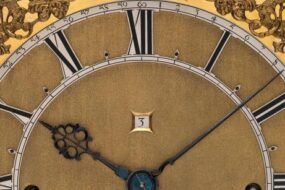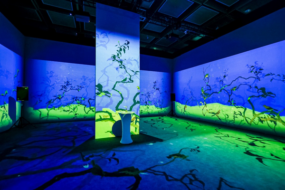
Claire Silver’s digital image “Daughter,” which is on the auction block with an estimated price … [+]
Fine-arts auction house Christie’s is set to launch “Augmented Intelligence,” its first auction devoted entirely to art created with the help of AI. But as debate over the intersection of AI and art intensifies, some artists are calling for its cancellation.
The auction will run from Feb. 20 through March 5, with a concurrent exhibit at Christie’s Rockefeller Center galleries in New York. “Augmented Intelligence” will feature more than 20 lots — from digital art to sculptures, acrylic and oil paintings and inks on paper.
“AI technology is undoubtedly the future, and its connection to creativity will become increasingly important,” Nicole Sales Giles, Christie’s director of digital art, said in a statement announcing the auction on Friday. Christie’s has sold AI art before but hasn’t focused an entire auction on it until now.
The auction comes as some artists embrace artificial intelligence as an exciting creative partner, while others accuse companies of stealing their work to train AI datasets without credit or compensation. An open letter dated Saturday calls on Christie’s to cancel the auction and has so far gathered more than 3,700 signatures.
“Augmented Intelligence” will include works by early pioneers of algorithmic art and prominent contemporary digital artists such as Refik Anadol, who used AI to interpret and transform more than 200 works from New York’s Museum of Modern Art. He also co-founded Dataland, a Los Angeles venue billed as the first museum of AI arts that’s scheduled to open later this year.
Anadol’s piece in the Christie’s auction comes from “Machine Hallucinations,” a series of otherworldly “AI data paintings” made with a model trained on a set of curated images from NASA’s Mars Reconnaissance Orbiter. The video piece lists with an estimated auction price of between $150,000 and $200,000.
This piece from artist Refik Anadol’s “Machine Hallucinations” series will soon be up for auction by … [+]
Also on the block is an “AI poem sculpture” by Sasha Stiles that presents the sentiment “words can communicate beyond words” in a 36-inch square black matte steel and LED neon lightbox. Stiles collaborates with an algorithmic alter-ego trained on her poetry, and she created a writing system that fuses her own handwriting with the zeroes and 1s of machine speak.
Then there’s Alexander Reben’s “Untitled Robot Painting,” which merges generative AI and live performance. The 10×12 foot acrylic evolves over time, with a robot adding to the canvas each time someone places a new bid on the work. Auction price estimates span a staggering gap, from $100 all the way up to $1.7 million.
Reben last year completed a stint as the first artist in residence at OpenAI, maker of Dall-e, one of several popular generative AI tools that allow anyone to create an image with typed or spoken prompts. Products like Dall-e, Midjourney and Stable Diffusion have made AI art experimentation accessible to the masses, with the results filling Instagram feeds and Reddit forums — and catapulting AI art to the center of the heated discussion reflected in the open letter to Christie’s.
Alexander Reben’s “Untitled Robot Painting,” which merges generative AI and live performance.
“Many of the artworks you plan to auction were created using AI models that are known to be trained on copyrighted work without a license,” the letter reads. “These models, and the companies behind them, exploit human artists, using their work without permission or payment to build commercial AI products that compete with them.”
Christie’s didn’t immediately respond to a request for comment on the pushback, but a company spokesperson told TechCrunch that “the artists represented in this sale all have strong, existing multidisciplinary art practices, some recognized in leading museum collections. The works in this auction are using artificial intelligence to enhance their bodies of work and in most cases, AI is being employed in a controlled manner, with data trained on the artists’ own inputs.”
In announcing the auction, Christie’s addressed another common concern expressed by some artists — that AI could replace them altogether. AI art of the caliber demonstrated in the auction is neither a shortcut to productivity nor a replacement for human discernment, Christie’s said.
AI As Partner, Not Human Substitute
AI “enhances the human spectrum of creativity,” Sales Giles said. “It’s about employing technology to push what is possible, exploring what is achievable outside of, but not separate from, human agency.”
It’s a view echoed often by artists at the forefront of the AI art frontier.
“I collaborate with AI to produce art that is transcendental, art that evokes in the viewer a wordless truth,” Claire Silver, whose digital image “Daughter” appears in the auction, said in an artist’s statement. “Together, we create works that are greater than either of us could make alone, neither more important than the other to the process.”
Silver is among the artists who view AI as a collaborative tool and challenge the assumption that AI can instantaneously produce a perfectly crafted, exhibit-ready work without human intervention.
“Sometimes we hold AI to some sort of impossible set of standards where we ask systems to do entire jokes, entire shows, entire movies or entire songs themselves, and really, that’s never been the point,” Cristóbal Valenzuela, co-founder and CEO of AI start-up Runway, maker of a tool that generates videos from text, images or video clips, told me last year. “You can choose which parts you’re going to incorporate. It’s up to you as an artist how you want to best utilize it.”
Holly Herndon and Mat Dryhurst explore AI’s role in shaping identity with a work from a … [+]











